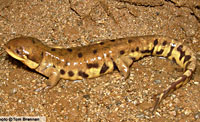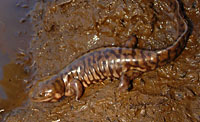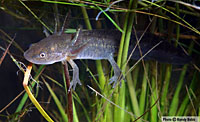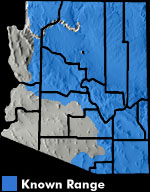Online Field Guide to The Reptiles and Amphibians of Arizona


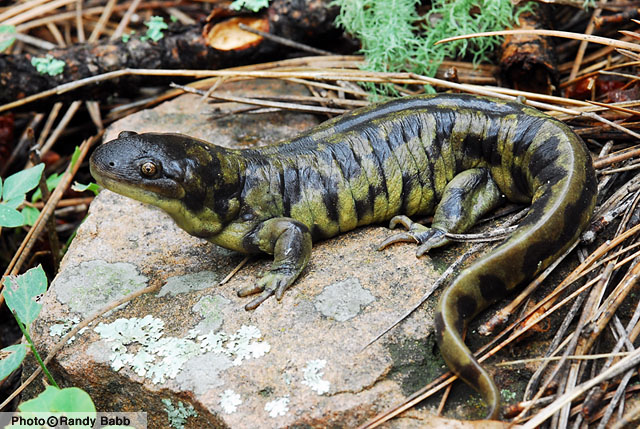
Ambytstoma mavortium nebulosum. Gila County, AZ
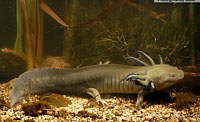 Gilled adult. Pinal Co., AZ |
||
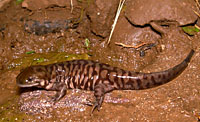 A. m. stebbinsi Santa Cruz Co., AZ |
| BARRED TIGER SALAMANDER Ambystoma mavortium | |
|
DESCRIPTION: As Arizona’s only salamander, this species is unmistakable. Adult, terrestrial tiger salamanders grow to as much as 13.6 inches total length and 6.5 inches snout-vent length. They exhibit varying combinations of dorsal light and dark spots, bars, or reticulation. The Arizona tiger salamander (A. m. nebulosum), known from the Mogollon Rim area and the Colorado Plateau, is typically a dark grayish to olive salamander with irregularly-shaped yellow to olive spots and blotches (but see photo above). The barred tiger salamander (A. m. mavortium), which has been widely introduced by anglers and bait collectors to much of southeastern Arizona and is sometimes encountered elsewhere in southern Arizona, has large, distinct yellowish bars or spots on a dark background. The Sonoran tiger salamander (A. m. stebbinsi), an endangered subspecies from the San Rafael Valley, possesses a unique reticulate pattern on a dark background, but many are indistinguishable from the barred salamander. Larvae and gilled adults, called branchiates or neotenes, are aquatic, olive-gray, and possess three gills on each side of the head. Early in development, larval salamanders lack legs. Arizona and barred branchiate salamanders, and very rarely, Sonoran tiger branchiates, may develop into large (up to 15 inches total length), big-headed, cannibalistic morphs. DISTRIBUTION: Tiger salamanders can be found throughout much of Arizona outside of the lower and more arid southwestern and western deserts. They are widely used as fish bait, and so may occasionally be encountered as an introduction outside of their mapped range. HABITAT: Tiger salamanders breed in the still or sluggish waters of ponds, cattle tanks, backwaters, and lakes; often in open country. They breed in permanent or ephemeral wetlands, but the former often contain predators (e.g. fishes) that preclude or limit recruitment. When not breeding, terrestrial adults can be found in the uplands, often on roads at night during storms, sometimes as far as 2-3 miles from the breeding pond. The Sonoran tiger salamander is found in the grasslands of the San Rafael Valley and adjacent foothills of the Huachuca and Patagonia mountains. Arizona tiger salamanders occur in coniferous forests, chaparral, and high grasslands; and barred salamanders occur primarily in desert scrub and semi-desert grassland. DIET: Larvae and branchiates feed on a wide variety of invertebrates. Cannabilistic morphs eat larger prey and may preferentially eat their own kind. Terrestrial adults feed on a variety of surface and subterranean invertebrates. Adults and large larvae will eat vertebrates, as well, including tadpoles, lizards, small snakes, and mice. REPRODUCTION: Breeding occurs from mid-winter into late spring; and rarely in late summer. Terrestrial adults typically return to their natal ponds to breed. Females lay 200-2,000 eggs individually or in small groups attached to sticks, aquatic vegetation, debris, or on the substrate. Eggs take 14-50 days to hatch, depending on water temperature. Larvae can metamorphose in as little as 2 months, but growth varies with a number of factors. The larval period is typically longer than 2 months, and some overwinter. REMARKS: The Sonoran tiger salamander was listed as an endangered species under the Endangered Species Act in 1997. A recovery plan was completed in 2002. Threats to its existence include predation by non-native species, particularly fishes; die-offs due to an iridovirus; hybridization with introduced barred salamanders; and drought. This subspecies breeds in cattle tanks and impounded ciénegas. Its natural habitats – presumably natural ciénegas, springs, and perhaps backwaters of the Santa Cruz River – are now gone or overrun by non-native predators.
Collins, J.P. 1981. Distribution, habitats, and life history variation in the tiger salamander, Ambystoma tigrinum, in east-central and southeast Arizona. Copeia 1981:666-675. Degenhardt, W.G., C.W. Painter, and A.H. Price. 1996. Amphibians and Reptiles of New Mexico. University of New Mexico Press, Albuquerque. Lannoo, M.J., and C.A. Phillips. 2005. Ambystoma tigrinum (Green, 1825). Pages 636-639 in M.J. Lannoo (ed), Amphibian Declines: The Conservation Status of United States Species. University of California Press, Berkeley. Petranka, J.W. 1998. Salamanders of the United States and Canada. Smithsonian Institution Press, Washington D.C. U.S. Fish and Wildlife Service. 2002. Sonora tiger salamander (Ambystoma tigrinum stebbinsi) recovery plan. U.S. Fish and Wildlife Service, Region 2, Albuquerque, NM. |
|
Visit Partners in Amphibian and Reptile Conservation:


HOME
Copyright © 2023, Arizona Game and Fish Department. All rights reserved.
If you make use of the textual contents of this site in reports, publications, etc. please cite and credit the author(s) and photographer(s). All photos on this website are copyrighted. However, those found in the species account section may be used for any noncommercial scientific, educational, or conservation purposes provided that photographs are not altered and continue to bear the copyright symbol and name of the photographer. Please contact the photographer regarding commercial use of copyrighted photographs.










